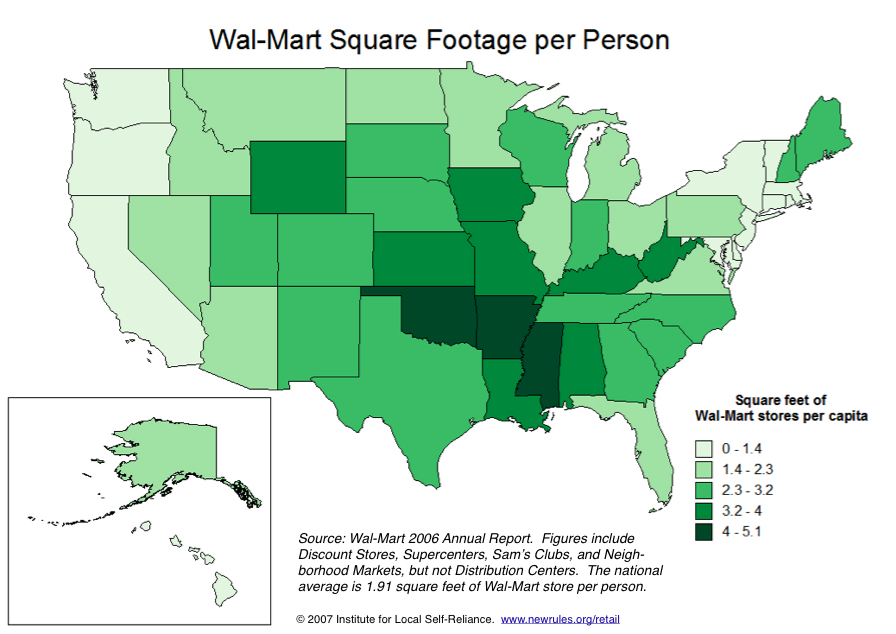Tesco — a British-based chain and the world’s fifth largest retailer — wants to open 100 stores in the western U.S. by early 2008 and another 400 outlets over the next few years.
The company is “looking to build as big a business in the United States as it has in the United Kingdom,” according to chief executive Terry Leahy. In Britain, Tesco operates 2,000 supermarkets and hypermarkets, which are like Wal-Mart supercenters. It captures one of every eight dollars spent at British stores and nearly one-third of all spending on groceries.
Tesco has just as much store space outside of the U.K. as it does within the country. It operates in 11 other nations, including Thailand, where it has 370 hypermarkets, and Poland, where it has 280.
Because of its market power and a history of abusive and predatory behavior, Tesco, much like Wal-Mart, has been the target of extensive criticism and highly visible campaigns by numerous labor, environmental, and community organizations in the U.K. and abroad. (Many of these groups are united as part of the Tescopoly coalition.)
Perhaps in an attempt to shed this negative image and obscure its identity as a global corporation, Tesco will operate its U.S. stores under the name “Fresh & Easy Neighborhood Market.” Although the chain primarily operates massive hypermarkets, its initial U.S. roll-out will consist of grocery stores of 10-15,000 square feet.
What can we expect from Tesco in the U.S.? The Urban & Environmental Policy Institute at Occidental College in Los Angeles tackled this question in a recent report that examines multiple facets of Tesco’s operations. Among the highlights:
- Tesco finds the U.S. appealing in part because it is such a large market and also because it lacks the U.K.’s more rigorous planning laws. (Those laws are currently under threat due to a massive campaign by Tesco and Wal-Mart to weaken British planning policy.)
- Tesco plans a saturation strategy in the U.S. in which it will concentrate large numbers of stores in relatively small areas. Its initial deployment of 500 outlets will be located in only a handful of metro areas, including Los Angeles, San Diego, Las Vegas, and Phoenix.
- In Britain, Tesco has a well-documented history of predatory pricing. To deal with a particularly strong independent competitor in Withernsea, for example, Tesco sold everything in its outlet below cost, dropping prices by 40 percent across the board. Once customer traffic had shifted to Tesco and the competitor had been sufficiently weakened, Tesco’s prices inched up.
- Although Tesco has received glowing media coverage in the U.S. for stating that it would locate many of its stores in “food deserts” — poor urban neighborhoods that lack full-service grocery stores — an analysis by UEPI found that more than half (56%) of Tesco’s announced store sites are in census tracts with higher-than-average incomes. A majority of locations (71%) are in tracts where the poverty rate is lower than the county average. Indeed, many of Tesco’s stores are being build in expanding suburban locations.
- Of the 10 poor neighborhoods where Tesco plans to build, 7 are not in fact lacking access to full-service grocery stores. Indeed, in some of these neighborhoods, “Tesco may undercut long standing independent stores or ethnic markets”
- Tesco will staff its U.S. stores entirely with part-time workers.
- Although the chain is unionized in the U.K., its U.S. division has not made a commitment to working with the UFCW. In 2006, the division placed an ad for two senior human relations positions that would have “primary responsibility for. . . maintaining non-union status and union avoidance activities.”
- According to the U.K.’s Competition Commission, Tesco has engaged in numerous illegal and anticompetitive practices, exploiting its market power to exact discounts and other concessions from farmers and suppliers and to place smaller retailers at a disadvantage. (See “New Code Won’t Break British Chains’ Armlock on Farmers.”)
- Although “in marketing its ‘fresh’ identity, Tesco may well provide the impression that it is sourcing a greater quantity of local products than its competitors are,” Tesco will in fact source very little of the food it carries locally. About half the products in its stores will be its own in-house, or private label, brand.




